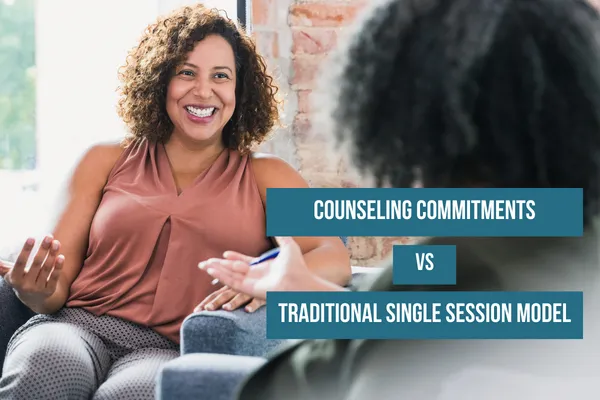
The Advantages of Counseling Commitments Vs Traditional Single Session Model
Hey Private Practice Counselors,
Have you ever stopped to consider if your approach could be unintentionally leading clients to leave therapy too soon, without the transformation they are seeking?
My own moment of realization came after a year of introspection into my practice, where I found that a staggering number of clients - over 60 percent- had discontinued their sessions before even reaching the fifth one. I literally did not know or would have guessed because I was only remembering the clients that stayed long term. I would not have known if I did not run the numbers!
Here I was, thinking I had a consistent client base, only to discover a pattern of premature drop-offs that was too significant to ignore.
In this post, I'll share how shifting to a committed session structure not only enhanced my clients' healing but also significantly improved my practice.
Today in 5 minutes or less, you'll learn:
Understanding Client Retention: Why clients may discontinue therapy early in a single session model and how a counseling commitment can improve retention.
Benefits of Structured Therapy: Exploring the advantages of a structured approach for deeper and more effective results.
Setting Expectations: Strategies for effectively setting and managing client expectations to foster commitment and clear therapeutic goals.
The Illusion of the Flexible Approach
In my early days, I was a supporter of the 'one session at a time' model. The idea was to offer maximum flexibility, allowing clients to choose their sessions at their convenience, with no obligation. It seemed foolproof on paper, but in practice, it was far from effective.
Unraveling the Traditional Model
As I revisited this conventional method, I saw recurring themes - unresolved issues, frequent no-shows, last-minute cancellations, and limited progress. More critically, many clients were leaving therapy right when we were beginning to delve into deeper issues. They would stabilize and feel some relief and then believe they "were all better" but they had not done enough work or given it enough time for the changes to really take root. It was a cycle of surface level engagement, far from the transformative results both I and my clients aimed for.
The Epiphany: The Need for Structure and Commitment
That's when the lightbulb moment happened. I understood that therapy, much like fitness, requires time, effort, and consistency. Recommending a predefined set of sessions upfront wasn't just about commitment; it was about providing focus, clarity on goals, and a shared understanding of the journey to meaningful change. It wasn't the client's fault either. I did not set the expectation and give proper guidance of how long they would need to work on an issue for a reasonable amount of progress.
Why the 'One Session at a Time' Model Falls Short
This model, I realized, is flawed in its inability to foster deep, lasting change. It lacks the necessary structure and consistency, and it fails to build a committed client base willing to engage in the work required for real transformation. The traditional model creates an ambiguity of how long they will be in treatment. My clients know we work off of 12 session cycles and this has lead to them being so much focused and invested in the process. It's so refreshing to actually have clients complete the homework and work on the skills outside of our sessions! They know we are only working on 1-2 goals during that 12 sessions and we are going to maximize our time together.
The Game Changer: Structured Client Plans
I shifted gears, implementing structured schedules, fixed meeting times, and clear discussions about the expected duration for achieving goals. This new approach revolutionized not only my clients' experiences but also the health of my practice.
By introducing a structured schedule, meeting day and time, and discussing my professional opinion on how long it will take to reach their goals, I was able to transform my practice issues and help my clients reach new levels of success.
Now I clearly communicate that progress requires a time, effort, and consistency to see results. Having this clear communication has helped clients and myself to be more intentional and do more meaningful work.
If you're seeing that your practice has plateaued and could be doing better and you're wanting to take your clients and practice to the next level then I invite you to join me in reshaping your private practice.
In my upcoming webinar, we'll explore how structured client programs can create commitment and lead to remarkable results.


Facebook
Instagram
Youtube